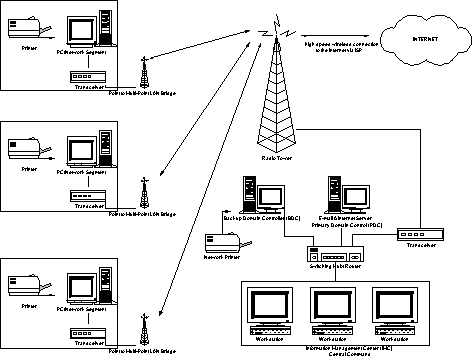| |
|
Computerization & Networking |
| |
|
METROPOLITAN AREA
NETWORK (MAN)
Wireless LAN Bridge |
| |
|
INTRODUCTION
Metropolitan Area Network (MAN) is the
interconnectivity of Local Area Networks within a city or in
proximity to each other. At Agile, we utilize robust Wireless
LAN Bridge Technology to bridge the network segments. Our
solution is designed to offer high speed interconnectivity
between buildings separated by location, road networks,
railroads, rough terrain and other "insurmountable" obstacles.
It uses microwave radio link to bridge Local Area Networks
(LAN) in the buildings or location being interconnected. Often
the local network employs wired technology while
interconnection to other local networks is achieved via
microwave radio.
Our bridging technology supports up to
11Mbps streaming speed and can cover ranges up to 15KM radius
without the need for boosters or signal repeaters. Our
Wireless LAN Bridge is suitable for networking buildings or
location within a city without the aggravation of citywide
cabling, wiring or licensing. The technology is controlled via
an access point, the Information Management Center (IMC),
which can be located anywhere in the city, under the
management of authorized personnel.
There is no limit to the number of client
computers that can be supported by the platform. The IMC is
fully capable of direct management of the client computers at
all interconnecting locations. The locations do not have to
duplicate network servers, hence streamlining personnel,
equipment and maintenance requirements. |
| |
|

|
| |
KEY TECHNOLOGY COMPONENTS
»
The Network Segments to be linked, and
»
The Information Management Center (IMC), which controls the
networks.
|
|
Network Segments
Network segments are
created based on location, function or workgroups. These
segments are connected to the larger network via broadband
single point microwave radio link. The connection is
permanent. The workstations in each network segment may be
administered directly from the IMC, although local
administration is also possible. All computers connected to
the network receive access rights to various resources in the
network, such as Internet connectivity.
Information Management Center
The Information Management Center (IMC) is
a central command that host the network servers and the
Internet servers. It interconnects all network segments or PCs
via broadband multi-point microwave radio link. It also links
up all connected computers to the Internet via a dedicated
broadband ISP. The IMC interconnects various networks within
the metropolis. Authorized users can access the network
irrespective of time and distance. Once a traveling user logs
on through the IMC, almost all computer tasks can be performed
from the user's local (office) account.
The IMC serves as an access point to the
connected networks and a network-wide Internet proxy as well.
The access server connects to the Internet and provides a
gateway for simultaneous access by the client computers, which
can now connect to the Internet from their various locations.
The access point is the hub of the Wireless LAN Bridge,
providing numerous other resources such as intranet, extranet,
wide area network links, e-mails, bulletin boards, remote
dialup options, etc.
The IMC is supported by two servers - the
Primary Domain Controller (PDC) and the Backup Domain
Controller (BDC) - both of which are also used for logon and
network management functions, file and resource server
functions, and internet proxy functions.
UTILITY
Some of the functions supported by this technology include:
»
High broadband access to the internet irrespective of location
»
Access to shared resources irrespective of location
»
Share and move documents across network segments and computers
»
Intercom (voice communication) using VOIP technology
»
Send and receive internal and external e-mails
»
Chat rooms, forums, bulletin boards, on-line classrooms, etc.
»
Internal web sites for departments and units within your
organization.
»
Teleconferencing - audio and video
ADVANTAGES OF WLAN
Freedom of mobility - The freedom to access real-time
information anywhere, anytime within a city or its environs or
in a multi-building complex without wires.
High speed data rates that equal wired
networks - Information can be accessed at 11Mbps, a data rate
crucial to modern business transactions.
Interoperability - Compliant equipment from
various vendors or brands can be used within the network.
Ease of Installation - Installing a WLAN
Bridge is fast and easy, and eliminates the expensive and
cumbersome process of cross city cabling and conduits.
Flexibility and Scalability - Wireless LANs
can be configured to meet the needs of a specific application,
from enterprise environment, to small business or even home
application.
Lower Cost - In the long run, Wireless LANs
costs less to own and operate. No more costly cable repairs.
Less is spent when offices are reconfigured or usage grows.
WEP encryption for high-speed LAN security
- Wireless LAN allows you to build comprehensive security
system to ensure that the wireless link does not compromise
your network. Wired Equivalent Privacy (WEP) can be
implemented to the 11Mbps access point, PC cards, ISA cards
and PCI adapters.
DELIVERABLES
» Supply of all
hardware and software required for implementation.
» Complete wired
networks in all buildings slated for interconnectivity.
» Wireless link of
the network segments with the access point located at the IMC.
» Complete
Intra/Extra-networking with advance Wireless LAN technology.
» Wired Equivalent
Privacy (WEP) security features and advanced NT firewall
technology.
» Citywide LAN
integrated Internet connectivity option.
» Intranet
(internal) private E-mail accounts for network users.
» Training of
personnel to use and manage computers on the network.
» Training of
personnel to administer the Wireless LAN.
» Remote dialup (PPPA
Slip) connection (Requires a Router). |
|
|
|
|
Networking Home
| LAN
| MAN/WLAN
|
WAN
| Intranet
|
On-line
Work Process
| Network Security |
|
|
|
|
|
| |
|